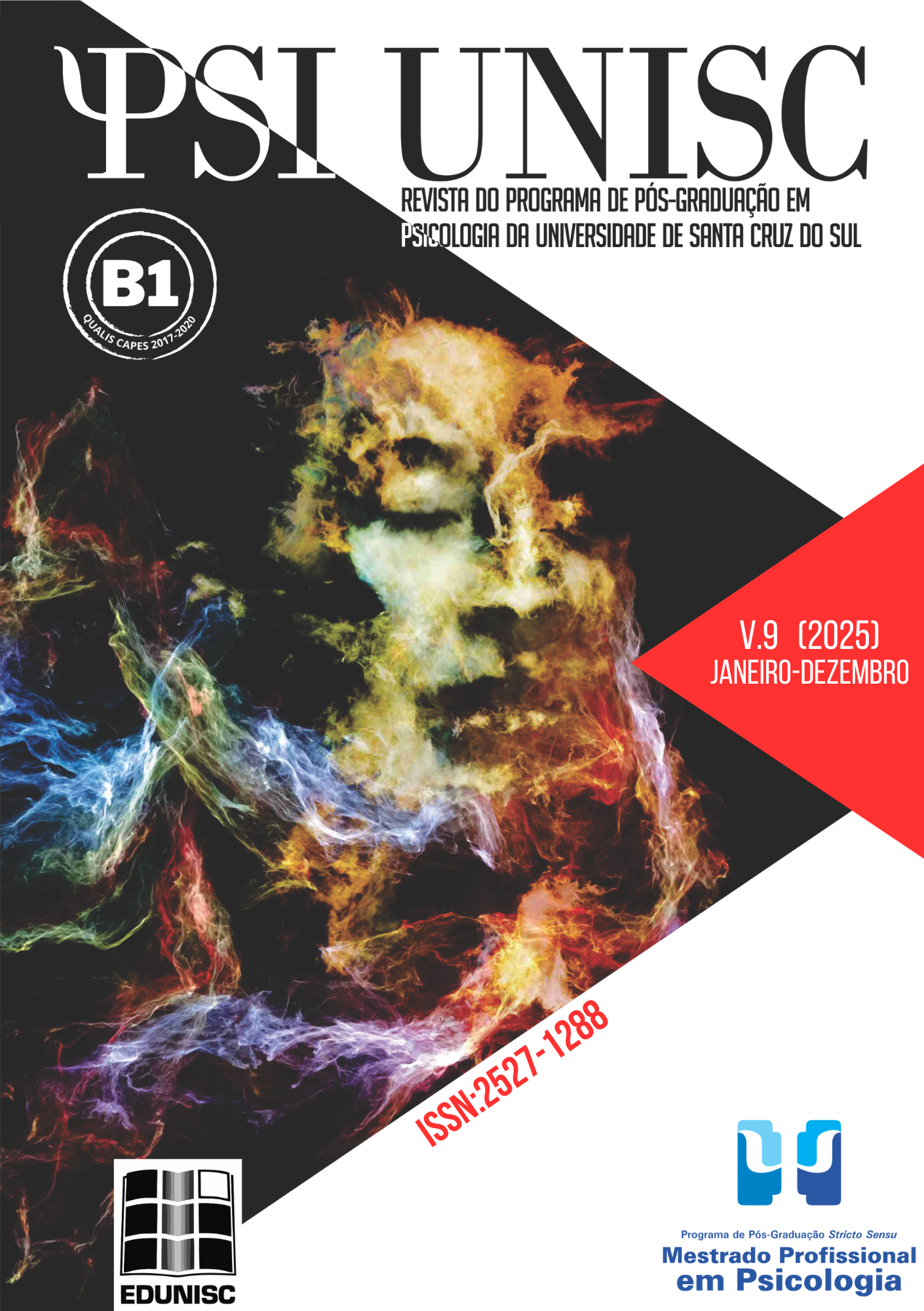Mental health of women, maternity and career: a literature review
DOI:
https://doi.org/10.17058/psiunisc.v9i.18526Keywords:
mental health, work, motherhoodAbstract
The numerous labor achievements of women in the world of work, ensured by the guarantee of their labor rights and the expansion of their scope of action in the labor market, are a strong portrayal of the sociocultural and economic transformations of gender relations regarding the social roles historically constructed for women. If, on the one hand, such achievements represent significant labor advances, on the other hand, they renew the debate on women's mental health in confronting traditional gender roles and the reconciliation between motherhood and career. With a greater presence in the labor market, the challenges of reconciling career and motherhood are increasingly present in the lives of mothers. One of the greatest challenges highlighted is mental health in the new routine after the arrival of the first child. The objective of this article is to analyze the scientific production of studies on the mental health of women who seek to reconcile motherhood and career. Searches were conducted in the Capes and BVS-Saúde databases and 76 articles were found, of which 03 were selected based on the established criteria. From the analysis of the findings, four points were highlighted: the naturalization of gender roles that make women solely responsible for individually creating strategies to manage the numerous maternal and work demands; the relevance of the support network for promoting self-care; the need to observe the different social and economic contexts that impact the creation of support networks; and the belief that conciliation is something that can be achieved, but not without conflicts.
Downloads
References
Alvarenga, P. et al. (2018). Variáveis sociodemográficas e saúde mental materna em contexto de vulnerabilidade social. Psicologia, Saúde & Doenças, 19(03), 776-788. doi: 10.15309/18psd190324.
Angerami, S.; Angerami, F. (2012). Bem me quer, Malmequer: Histórias verdadeiras de mulheres e suas escolhas de carreiras. São Paulo, Brasil: Évora.
Badinter, E. (1985). Um amor conquistado: O mito do amor materno. Rio de Janeiro, Brasil: Nova Fronteira.
Badinter, E. (2010). O conflito: a mulher e a mãe. Lisboa, Portugal: Relógio D’Água Editores.
Beltrame, G. R.; Donelli, T. M. S. (2012). Maternidade e carreira: desafios frente à conciliação de papéis. Aletheia, 38-39, 206-217.
Biffi, M.; Granato, T. M. M. (2017). Projeto de ter filhos: uma revisão da literatura científica nacional e internacional. Temas em Psicologia, 25(01), 207-220, 2017. doi: 10.9788/TP2017.1-14Pt.
Brasil, Ministério da Saúde. (2021). Painel de casos de doença pelo coronavírus 2019 (COVID-19). Recuperado de https://covid.saude.gov.br/
Bronfenbrenner, U. (1996). A ecologia do desenvolvimento humano: experimentos naturais e planejados. Porto Alegre: Artes Médicas.
Brunoni, A. R. et al. (2021). Prevalência e fatores de risco de sintomas psiquiátricos e diagnósticos antes e durante a pandemia de COVID-19: achados da coorte de saúde mental ELSA-Brasil COVID-19. Psychological Medicine, 53(2), 446-457. doi:10.1017/S0033291721001719.
Carneiro, S. (2003). Enegrecer o feminismo: A situação da mulher negra na América Latina a partir de uma perspectiva de gênero. In: Racismos contemporâneos (Vol. 49, pp. 49-58). Rio de Janeiro, Brasil: Takano Editora.
Carvalho Neto, A. M. de, Tanure, B., & Andrade, J. (2010). Executivas: Carreira, maternidade, amores e preconceitos. RAE-Eletrônica, 9(1). https://doi.org/10.1590/S1676-56482010000100004.
Crenshaw, K. (2004). A interseccionalidade na discriminação de raça e gênero. In: Cruzamento: Raça e gênero (pp. 7-16). Brasília, Brasil: Unifem.
Collins, P. H. (2019). Pensamento feminista negro: Conhecimento, consciência e a política do empoderamento (1ª ed.). São Paulo, Brasil: Boitempo.
Departamento Intersindical de Estatística e Estudos Socioeconômicos (DIEESE). (2023a). As dificuldades das mulheres chefes de família no mercado de trabalho. Recuperado de https://www.dieese.org.br/boletimespecial/2023/mulheres2023.pdf
Departamento Intersindical de Estatística e Estudos Socioeconômicos (DIEESE). (2023b). Mulheres: Inserção no mercado de trabalho. Recuperado de https://www.dieese.org.br/infografico/2023/infograficosMulheres2023.html
Dutra, J. S. (2017). Gestão de Carreiras: a pessoa, a organização e as oportunidades. 2.ed. São Paulo, Brasil: Atlas.
Evans, K. L. et al. (2016). Working sandwich generation women utilize strategies within and between roles to achieve role balance. PLoS ONE, 11(6). doi: 10.1371/journal.pone.0157469.
Giordani, R. C. F. et al. (2018). Maternidade e amamentação: identidade, corpo e gênero. Ciência & Saúde Coletiva, 23(8), 2731-2739. doi: 10.1590/1413-81232018238.14612016.
Gomes, A. G.; Donelli, T. M. S.; Piccinini, C. A.; Lopes, R. S. (2008). Maternidade em idade avançada: Aspectos teóricos e empíricos. Interação em Psicologia (Online), 12(1), 99-106. doi: 10.5380/psi.v12i1.5242.
Guimarães, M. da G. V.; Petean, E. B. L. (2012). Carreira e Família: divisão de tarefas domiciliares na vida de professoras universitárias. Revista Brasileira de Orientação Profissional, 13 (1), 103-110.
Hays, S. (1996). The cultural contradictions of motherhood. Yale University Press; New Haven, CT.
Hirata, H.; Kergoat, D. (2007). Novas configurações da divisão sexual do trabalho. Cadernos de pesquisa, 37(132), 595-609.
Hooks, b. (2019). Teoria feminista: Da margem ao centro. São Paulo, Brasil: Perspectiva.
Hooks, b. (2018). O feminismo é para todo o mundo. Rio de Janeiro, Brasil: Rosa dos Tempos.
Instituto Brasileiro de Geografia e Estatística - IBGE. (2018). Estatísticas de gênero: indicadores sociais das mulheres no Brasil. Recuperado de https://biblioteca.ibge.gov.br/visualizacao/livros/liv101551_informativo.pdf
Instituto Brasileiro de Geografia e Estatística - IBGE. (2022). As Mulheres do Brasil. Recuperado de https://educa.ibge.gov.br/jovens/materias-especiais/22052-as-mulheres-do-brasil.html
Lei n. 13.467, de 13 de julho de 2017. Altera a Consolidação das Leis do Trabalho (CLT), aprovada pelo Decreto-Lei nº 5.452, de 1º de maio de 1943, e as Leis n º 6.019, de 3 de janeiro de 1974, 8.036, de 11 de maio de 1990, e 8.212, de 24 de julho de 1991, a fim de adequar a legislação às novas relações de trabalho. Recuperado de https://www.planalto.gov.br/ccivil_03/_ato2015-2018/2017/lei/l13467.htm.
London, M.; Stumpf, S. (1982). Managing carccrs. Reuding, MA: Addison-Wesley.
Lopes, M. N., Dellazanna-Zanon, L. L., & Boeckel, M. G. (2014). A multiplicidade de papéis da mulher contemporânea e a maternidade tardia. Temas em Psicologia, 22(4), 917-928. https://doi.org/10.9788/TP2014.4-18
Mandalozzo, S. (1996). A maternidade no direito do trabalho. Curitiba, Brasil: Juruá.
Manente, M. V.; Rodrigues, O. M. P. R. (2016). Maternidade e Trabalho: Associação entre Depressão Pós-parto, Apoio Social e Satisfação Conjugal. Pensando famílias, 20(1), 99-111.
Maluf, S. W.; Tornquist, C. S. (Org.) (2010). Gênero, saúde e aflição: abordagens antropológicas. Florianópolis, Brasil: Letras Contemporâneas.
Michel, K.D.; Nunes, M.P. (2021). Mães Gestoras – Uma análise da influência da maternidade na vida profissional das líderes. Espacio Abierto, 31 (1), 30-54. Disponível em: https://www.redalyc.org/journal/122/12270216002/html/#redalyc_12270216002_ref53 . Acesso em: 15 jul. 2021.
Melo, C. V. B. de. (2019). Proteção à maternidade e licença parental no mundo. Disponível em: https://www.lexml.gov.br/urn/urn:lex:br:rede.virtual.bibliotecas:artigo.revista:2020;1001204910 . Acesso em: 15 jul. 2021.
Marks, I. M. (1987). Fears, phobias and rituals. New York. NY: Oxford University Press.
Oliveira, S. C.; Faria, E. R.; Sarriera, J. C.; Piccinini, C. A.; Trentini, C.M. (2011). Maternidade e trabalho: uma revisão da literatura. Interamerican Journal of Psychology, 45(2), 271-280.
Pateman, C. (1993). O contrato sexual. Rio de Janeiro: Paz e Terra.
Pinheiro, L.; Galiza, M.; Fontoura, N. (2009). Novos arranjos familiares, velhas convenções sociais de gênero: a licença-parental como política pública para lidar com essas tensões. Revista Estudos Feministas, 17(3), 851-859. doi: 10.1590/S0104-026X2009000300013.
Scott, J. (1995). Gênero: uma categoria útil de análise histórica. Revista Educação e Realidade, 20(2), 71-99.
Shreffler, K. M. (2017). Contextual Understanding of Lower Fertility Among U.S. Women in Professional Occupations. Journal of Family Issues, 38(2), 204-224. doi: 10.1177/0192513X166347.
Vanalli, A. C. G.; Barham, E. J. (2008). A demanda para políticas públicas adicionais para trabalhadores com filhos pequenos: o caso de professoras. Temas em Psicologia, 16(2), 231-241.
Véras, E. A.; Oliveira, F. P. M. (2017). Políticas Públicas para a maternidade: uma análise das licenças por maternidade e paternidade à luz da igualdade e da sustentabilidade social. Revista de Direito do Trabalho e Meio Ambiente do Trabalho, 3(1), 115 – 134. https://doi.org/10.26668/IndexLawJournals/2525-9857/2017.v3i1.1805
Yavorsky, J. E.; Dush, C. M. K.; Schoppe-Sullivan, S. J. (2015). The Production of Inequality: the gender division of labor across the transition to parenthood. The Gender Division of Labor Across the Transition to Parenthood. Journal of Marriage and Family, 77(3), 662-679. https://doi.org/10.1111/jomf.12189
Zanatta, E.; Pereira, C. R. R.; Alves, A. P. (2017). A experiência da maternidade pela primeira vez: as mudanças vivenciadas no tornar-se mãe. Pesquisas práticas psicossociais, 12 (3), 1-16.
Zanello, V. (2018). Saúde mental, gênero e dispositivos: Cultura e processos de subjetivação. Curitiba, Brasil: Appris.
Downloads
Published
How to Cite
Issue
Section
License
The submission of originals to this journal implies the transfer, by the authors, of the printed and digital publication rights. The copyrights for the published articles are those of the author, with periodical rights on the first publication. Authors may only use the same results in other publications clearly indicating this journal as the medium of the original publication. Because we are an open access journal, we allow free use of articles in educational and scientific applications provided the source is cited under the Creative Commons CC-BY license.




